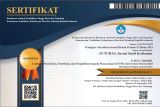An Analysis on The Sacred Realm of Kirab Pusaka
Authors (s)
(1) * Bakir Bakir
 (Universitas Nurul Jadid, Probolinggo)
(Universitas Nurul Jadid, Probolinggo) Indonesia
(*) Corresponding Author
AbstractImportant lines of issues on which this study is based to reveal the religious phenomena of Kirab Pusaka. The first is that Kirab Pusaka is a mysterium reality in the sense of that it has represented the certain rituals held by the Solo Palace as the center of people. For this purpose, this study will examine how Kirab Pusaka could be the sacred, and how the Solo Palace is spiritually regarded as the center of the sacred. The second is about construction of Kirab Pusaka as the sacred especially for Solo people. It is important to not only study this event by taking a distance between the researcher and the object of the research, but also to directly experience it as the involded person. The researcher will have important role to manifest his experiences during interview with some people and observation in the field. Keywords: Kirab Pusaka, Mysterium Reality, and The Sacred. |
Full Text: PDF
Refbacks
- There are currently no refbacks.
Copyright (c) 2018 Bakir Bakir
This journal is licensed under a
Creative Commons Attribution-ShareAlike 4.0 International License





.png)






